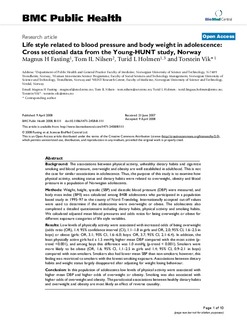Life style related to blood pressure and body weight in adolescence: Cross sectional data from the Young-HUNT study, Norway
Journal article, Peer reviewed
Permanent lenke
http://hdl.handle.net/11250/1552272Utgivelsesdato
2008Metadata
Vis full innførselSamlinger
Sammendrag
Background
The associations between physical activity, unhealthy dietary habits and cigarette smoking and blood pressure, overweight and obesity are well established in adulthood. This is not the case for similar associations in adolescence. Thus, the purpose of this study is to examine how physical activity, smoking status and dietary habits were related to overweight, obesity and blood pressure in a population of Norwegian adolescents.
Methods
Weight, height, systolic (SBP) and diastolic blood pressure (DBP) were measured, and body mass index (BMI) was calculated among 8408 adolescents who participated in a population based study in 1995–97 in the county of Nord-Trøndelag. Internationally accepted cut-off values were used to determine if the adolescents were overweight or obese. The adolescents also completed a detailed questionnaire including dietary habits, physical activity and smoking habits. We calculated adjusted mean blood pressures and odds ratios for being overweight or obese for different exposure categories of life style variables.
Results
Low levels of physically activity were associated with increased odds of being overweight (odds ratio (OR), 1.4; 95% confidence interval (CI), 1.1–1.8 in girls and OR, 2.0; 95% CI, 1.6–2.5 in boys) or obese (girls: OR, 3.1; 95% CI, 1.6–6.0; boys: OR, 3.7; 95% CI, 2.1–6.4). In addition, the least physically active girls had a 1.5 mmHg higher mean DBP compared with the most active (p-trend <0.001), and among boys this difference was 1.0 mmHg (p-trend < 0.001). Smokers were more likely to be obese (OR, 1.6; 95% CI, 1.1–2.5 in girls and 1.4; 95% CI, 0.9–2.1 in boys) compared with non-smokers. Smokers also had lower mean SBP than non-smokers; however, this finding was restricted to smokers with the lowest smoking exposure. Associations between dietary habits and weight status largely disappeared after adjusting for weight losing behaviour.
Conclusion
In this population of adolescents low levels of physical activity were associated with higher mean DBP and higher odds of overweight or obesity. Smoking was also associated with higher odds of overweight and obesity. The paradoxical associations between healthy dietary habits and overweight and obesity are most likely an effect of reverse causality.
